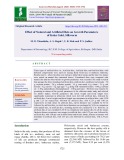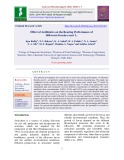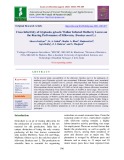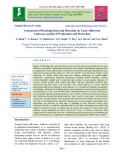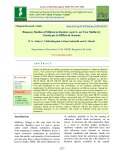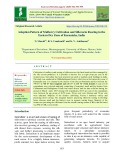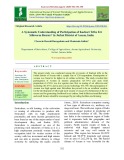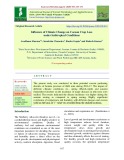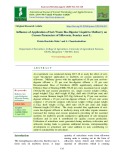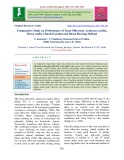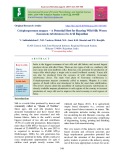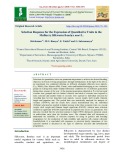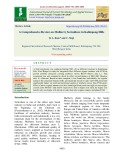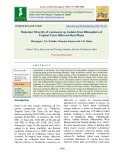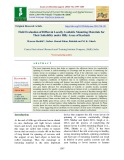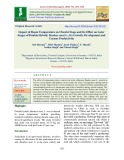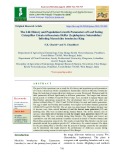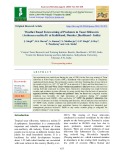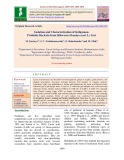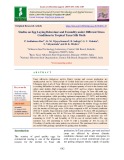
Silkworm rearing
-
=Three types of artificial diets viz., Artificial diet1, Artificial diet2 and Artificial diet3 with different compositions were used for rearing Kolar Gold race of mulberry silkworm, Bombyx mori L. where the diets were fed up to initial three instars and the later two instars were reared on natural diet (untreated leaves). Formulated diets were compared with natural diet and the observations on growth parameters were recorded.
 8p
8p  cothumenhmong11
cothumenhmong11
 11-05-2021
11-05-2021
 6
6
 2
2
 Download
Download
-
The present investigation was carried out to assess the rearing performance of silkworm Bombyx mori L. on antibiotic supplemented feed at various concentrations. The study was conducted on the silkworm breed APS-45. The worms were reared upto 3rd moult by feeding on mulberry leaves without any treatment.
 7p
7p  trinhthamhodang11
trinhthamhodang11
 27-04-2021
27-04-2021
 6
6
 1
1
 Download
Download
-
In the present study, susceptibility of the silkworm, Bombyx mori to the pathogens of mulberry pest Glyphodes pyloalis was ascertained. Silkworm, Bombyx mori inoculated with the pathogens isolated from G. pyloalis (Microsporidian and Nuclear Polyhedral Virus) showed high mortality at larval and pupal stages. Silkworms inoculated with Microsporidian showed mortality of 53.66% at larval stage whereas silkworms inoculated with Nuclear Polyhedral Virus showed mortality of 61.00% at larval stage.
 10p
10p  trinhthamhodang11
trinhthamhodang11
 27-04-2021
27-04-2021
 12
12
 1
1
 Download
Download
-
The study was conducted during the years 2016 in the first crop rearing season of the Tasar silkworm Antherae amylitta Dat Pilot Project Centre (PPC), Kathikund, Dumaka, Jharkhand located at 24°21′32″N 87°25′11″E,to study the “Impact of brushing date and direction on pest severity and cocoon production of tasar silkworm’.
 7p
7p  cothumenhmong9
cothumenhmong9
 04-01-2021
04-01-2021
 10
10
 2
2
 Download
Download
-
Studies on different tree mulberry genotypes on rearing performance of silkworm (Bombyx mori L.) was carried out to identify the best performing genotypes based on the bioassay performance of silkworm cross breed PM x CSR2 during rainy, winter and summer seasons of 2018-19at the Department of Sericulture, University of Agricultural Sciences, GKVK, Bangalore. The present study comprised of six mulberry genotypes viz., MI-012, MI-79, MI-21, MI-139, MI-516, ME-05 and two check varieties V1 and M5.
 9p
9p  trinhthamhodang9
trinhthamhodang9
 16-12-2020
16-12-2020
 14
14
 3
3
 Download
Download
-
Sericulture has been practiced on small or medium sized holdings in our country, the remunerative return from sericulture has enabled a few large-scale ventures also.
 7p
7p  caygaocaolon7
caygaocaolon7
 18-09-2020
18-09-2020
 10
10
 1
1
 Download
Download
-
The present study was conducted among the eri rearers of Kachari tribe in the Jorhat district of Assam with a sample size of 120 respondents. Participation of women was found to be higher in eri culture activities. The study revealed that participation of women in nursery preparation (23.75%) and main field preparation (14.76%) was low against men. But, in rearing of eri silkworm and marketing (81.67%) and in post cocoon technology (93.33%) the participation of women was high against men.
 7p
7p  caygaocaolon7
caygaocaolon7
 18-09-2020
18-09-2020
 7
7
 1
1
 Download
Download
-
The present study was conducted in three potential cocoon producing districts of Jammu province of J&K state during 2016-17. The impact of different climatic conditions viz., spring (March-April) and autumn (September-October) on the incidence of major diseases in silkworm were studied. The results indicated the disease incidence was higher during the autumn rearing as compared to spring rearing. Highly significant correlation of temperature and humidity with different diseases and cocoon yield on the basis of ‘r’ value was recorded from the studied locations.
 5p
5p  caygaocaolon6
caygaocaolon6
 30-07-2020
30-07-2020
 16
16
 1
1
 Download
Download
-
The study revealed that, application of seriwaste bio-digester effluent to mulberry along with other organic manures increased the rearing and cocoon parameters providing all the essential nutrients for mulberry growth compared to application of sole inorganic fertilizers and in turn it contributed for quality cocoon production. Utilization of sericulture waste generated during mulberry cultivation and silkworm rearing leads to generate additional income, entrepreneurship development in sericulture and value addition in turn contributing to achieve sustainability in sericulture.
 5p
5p  angicungduoc6
angicungduoc6
 22-07-2020
22-07-2020
 6
6
 1
1
 Download
Download
-
A comparative experiment study was carried out with chawki and direct brushing tasar silkworm on the tasar silkworm’s host plant Arjun leaves. The chawki method was carried out during I and II instars larva followed succeeding instars brushed in common plot whereas, direct brushing method was reared entire life cycles in common block plantation plots. The results indicated duration of silkworm larva was observed four days earlier with reared in chawki method than direct brushing method. Mortality rate of silkworm was found minimum under Chawki method.
 5p
5p  angicungduoc6
angicungduoc6
 20-07-2020
20-07-2020
 8
8
 1
1
 Download
Download
-
India is the biggest consumer of raw silk and silk fabrics and second largest producer of raw silk after China. There are two types of silk viz., mulberry silk and vanya silk (non-mulberry silk). India has vast potential for production of vanya silks which plays a major role in rural livelihood security. Vanya silk can also be produced from the cocoons of wild silkworm, Gonometa rufobrunnea insect. The main food plant of Gonometa rufobrunnea is Colophospermum mopane commonly called as mopane. Mopane is a xeric species of South Africa and introduced in India for sand dune stabilization.
 12p
12p  chauchaungayxua6
chauchaungayxua6
 26-06-2020
26-06-2020
 12
12
 2
2
 Download
Download
-
Selection response for the expression of quantitative traits in the Mulberry Silkworm Bombyx mori L.
Selections for quantitative traits are paramount importance to achieve the desired breeding objectives in breed evolving programmes through hybridization. In the light of the above, an experiment was conducted utilizing six different aboriginal silkworm races namely, C108, NB4D2, Pure Mysore (PM), Nistari, zebra and knobbed belonging to two voltinistic groups by rearing them under standard laboratory conditions for six different generations during three seasons of the year.
 19p
19p  gaocaolon5
gaocaolon5
 14-06-2020
14-06-2020
 17
17
 2
2
 Download
Download
-
A field experiment was conducted during 2011–16 in different locations in Kalimpong hills, West Bengal to study the integrated effect different organic manures with FYM on growth attribute characters existing mulberry variety BC259 (Morus alba L.).
 11p
11p  trinhthamhodang1213
trinhthamhodang1213
 29-05-2020
29-05-2020
 6
6
 0
0
 Download
Download
-
Azotobacter is an aerobic, free living bacteria fixes atmospheric nitrogen in soil besides producing plant growth promoting substance. Eight Azotobacter isolates were isolated and purified from different tasar rearing regions of West Singhbhoom, Jharkhand on Jenson media by using serial dilution technique. Molecular diversity among these isolates was analysed using RAPD primers.
 7p
7p  trinhthamhodang5
trinhthamhodang5
 16-05-2020
16-05-2020
 13
13
 1
1
 Download
Download
-
The most important device that helps or supports the silkworm larvae for comfortable spinning of cocoons is called mountage or cocoonage and the process of transfering the mature larvae on mountage is called mounting. Even if the silkworm crop is healthy, wrong mounting methods, spinning conditions and bad type of mounting material can result in inferior or poor quality cocoons and silk yarn leading to lower income to farmers.
 9p
9p  chauchaungayxua5
chauchaungayxua5
 08-05-2020
08-05-2020
 11
11
 1
1
 Download
Download
-
The effect of temperature plays a crucial role in the silkworm, Bombyx mori L., growth as well as cocoon quality and quantity. In this study, the effect of temperature during chawki rearing on later stages and its cocoon production was evaluated without maintaining any recommended practices of temperature and relative humidity during chawki rearing. The perusal of the data reveals that, the larval duration was observed as 28 days and 3 hours. It was observed that the second moult was the longest about 53 hours. Single cocoon weight was observed as 2.22 g, single shell weight was 0.
 6p
6p  chauchaungayxua5
chauchaungayxua5
 08-05-2020
08-05-2020
 15
15
 0
0
 Download
Download
-
The goal of this experiment was to study the life history and population growth parameters of Cricula trifenestrata Helfer (Lepidoptera: Saturniidae) reared on Machilus bombycina King, the food plant of muga silkworm (Antheraea assama Westwood). Biological and life table parameters differed significantly in different generations. The longest and shortest larval period of 43.68±1.34 and 38.67±1.13 days were recorded in January-March and May-October generations respectively.
 8p
8p  cothumenhmong4
cothumenhmong4
 25-03-2020
25-03-2020
 18
18
 0
0
 Download
Download
-
An experiment was carried out during the year of 2016 in the first crop rearing of Tasar silkworm at Pilot Project Centre (PPC), Kathikund with replicated thrice in completely randomized block design. The treatments consists with three brushing date of tasar larva in the month of July (i.e., 16th, 21st and 26th at an interval of 5 days) and four directions (i.e., North, South, East and West).
 6p
6p  cothumenhmong4
cothumenhmong4
 25-03-2020
25-03-2020
 8
8
 0
0
 Download
Download
-
Lactic acid bacteria are described as heterogeneous group of regular, gram-positive, rod shaped, non-motile, non-spore forming bacteria with absence of catalase enzyme. Laboratory study was undertaken to isolate and characterize the lactic acid bacteria from silkworm gut in phenotype basis. A total of 21 silkworm gut samples were collected from silkworm breeds, Double hybrid {(CSR 6 X CSR 26) X (CSR 2 X CSR 27)} obtained from Chawki rearing center (CRC) at Annur, Coimbatore.
 6p
6p  caygaocaolon2
caygaocaolon2
 11-03-2020
11-03-2020
 7
7
 0
0
 Download
Download
-
Tasar silkworm (Antheraea mylitta Drury) rearing and cocoon production are mainlycarried out by Tribal people of Central India and some parts of Odisha and Telangana states. Lack of Tasar silkworm seed production and preservationtechnology is creating difficulties in timely supply of adequate quantity of seed to the farmers and others stake holders..High temperature above 28ºC and less relative humidity than 50% are not suitable for the oviposition and hatching of eggs. In Tasar silk moth, egg retention was also more even after 72 h of oviposition in natural conditions.
 6p
6p  caygaocaolon3
caygaocaolon3
 09-03-2020
09-03-2020
 13
13
 0
0
 Download
Download
CHỦ ĐỀ BẠN MUỐN TÌM









